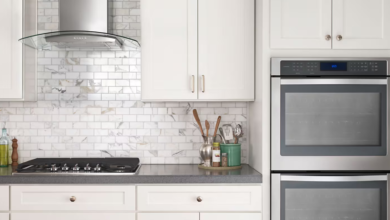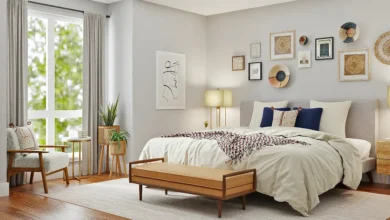Space Needed for Toilets: A Comprehensive Guide

Space Needed for Toilets: A Comprehensive Guide
Designing a purposeful and snug restroom entails more than simply selecting furniture and finishes. One of the maximum essential elements of a lavatory layout is making sure adequate space around the toilet. Proper spacing now not handiest influences usability but additionally influences hygiene and accessibility. This manual explores the important issues for figuring out the space wished for toilets, offering realistic recommendations for both residential and commercial programs.
Understanding Standard Toilet Dimensions
Before delving into spacing necessities, it’s helpful to apprehend the size of widespread toilets. Toilets normally come in two most important styles:
Two-Piece Toilets: These have a separate tank and bowl. They are flexible and easier to move.
One-Piece Toilets: These are streamlined with an unmarried unit, supplying a contemporary aesthetic and easier cleansing.
The regular dimensions for a trendy restroom are approximately:
Width: 14 to 16 inches
Depth: 27 to 30 inches
Height: 28 to 32 inches
These dimensions can range barely primarily based on the layout and manufacturer.
Minimum Clearances for Comfort and Accessibility
Proper clearance around a restroom is critical for both consolation and compliance with building codes. Here’s a breakdown of the minimum advocated clearances:
1. Front Clearance
The front clearance refers to the gap in front of the restroom. For the most effective comfort and capability, the minimum endorsed distance from the front of the restroom to any obstruction (like a cabinet or wall) is commonly 21 inches. However, 30 inches is favored to ensure sufficient room to be used and simplicity of cleaning.
2. Side Clearance
restroom is the space between the facet of the restroom and any adjoining fixture or wall. The minimal encouraged distance is 15 inches from the middle of the bathroom to any adjoining wall or fixture. This ensures sufficient area for customers to sit down comfortably and move approximately.
3. Distance from the Wall
The distance between the lower back of the bathroom and the wall has to be a minimum of 12 inches. This area contains the restroom’s tank and lets in for ease of setup and protection.
4. Accessibility Considerations
For reachable toilets, which should observe the Americans with Disabilities Act (ADA) or similar guidelines in other nations, the spacing requirements are more generous:
Front Clearance: forty-eight inches (to accommodate a wheelchair and make certain maneuverability).
Side Clearance: 16 to 18 inches from the center of the restroom to the wall or adjoining fixture.
Grab Bars: In addition to a clean area, ADA-compliant lavatories require clutch bars established around the restroom.
Space Planning for Different Bathroom Sizes
1. Small Bathrooms
In small lavatories, the area is regularly at a premium. To optimize space:
Consider Compact Fixtures: Choose a restroom with a smaller footprint.
Wall-Mounted Toilets: These can loose up ground area and make the room experience large.
Optimize Layout: Use space-saving designs, like nook lavatories, if format constraints are sizable.
2. Medium to Large Bathrooms
For medium to large toilets:
Standard Layouts: Adhere to advocated clearances for comfort.
Additional Features: Consider including extra functions such as a bidet or extra storage if the area lets in.
3. Commercial Bathrooms
Commercial Space Needed for Toilets, like those in workplaces or public spaces, require careful plans to satisfy building codes and accommodate excessive visitors:
High Traffic Areas: Allow for wider aisles and elevated clearances.
Compliance: Ensure that layouts follow neighborhood rules, which may additionally require extra space for accessibility.
Privacy and Aesthetic Considerations
In addition to the purposeful area, keep in mind privacy and aesthetic elements:
Partitions: In public or shared restrooms, walls can offer privacy and assist in outlining character restroom regions.
Design: A properly designed Space Needed for Toilets now not only effectively meets sensible desires but additionally enhances the general aesthetic of the distance. Choose fixtures and layouts that decorate the restroom’s appearance whilst ensuring ok capability.
Tips for Measuring and Planning
Measure Twice, Cut Once: Ensure correct measurements of each gap and the furnishings.
Create a Layout Plan: Use graph paper or digital layout equipment to plan the format before set up.
Consult Professionals: For complicated layouts or compliance with rules, consult with a professional fashion designer or architect.
Case Studies and Examples
To provide a sensible perspective, right here is some case research illustrating the software of these area recommendations:
Case Study 1: Urban Apartment Bathroom
In a small urban condo, the toilet was changed into designed with a wall-installed bathroom and a compact sink. The layout maximized ground area even as adhering to the 21-inch front clearance and 15-inch aspect clearance. The result turned into a functional toilet that felt spacious despite its small length.
Case Study 2: Office Building Restroom
In a high-visitor office restroom, clearances have been adjusted to house accessibility necessities. The format blanketed forty-eight inches of front clearance and 18 inches of facet clearance to make sure ease of use and compliance with ADA standards.
Case Study 3: Luxury Home Bathroom
A luxury domestic bathroom featured a larger layout with greater space around the bathroom for introduced consolation. The design included additional functions inclusive of a bidet and superior privateness with stylish partitions.
Conclusion
Determining the suitable space needed for toilets is an essential thing of the bathroom layout. By adhering to minimum clearance requirements, considering accessibility, and planning based on the dimensions and use of the restroom, you could create a functional, comfortable, and aesthetically pleasing space. Whether you’re designing a residential toilet or a commercial facility, considerate plans guarantee that the space meets each realistic and regulatory wishes, imparting a better enjoyment for all customers.



